Broken News
(All the News That's Fit to Reprint)
Costa Rica Not Invited to U.S. April Climate Summit
 The U.S. President was busy at the United Nations sponsored Glasgow Climate Change Summit (named COP26) inviting other major leaders to yet another climate change meeting he`s organizing for April in the U.S.. The Glasgow summit was most notable in it`s absence of high-population carbon polluters such as China, Russia and Brazil.
The U.S. President was busy at the United Nations sponsored Glasgow Climate Change Summit (named COP26) inviting other major leaders to yet another climate change meeting he`s organizing for April in the U.S.. The Glasgow summit was most notable in it`s absence of high-population carbon polluters such as China, Russia and Brazil.
Costa Rica, small at 5.2 million people, attended COP26 but as yet has not been invited to the April meeting. Did someone on the Biden staff overlook inviting the Ticos? Though a relatively small country, Costa Rica has an impressive program for generating green energy and conversion of vehicles to electric. Oh well, maybe the invitation will come later, there`s still 5 months to the new summit.
Futbol, Again!
GG heard a rumor that futbol had started again in our Futsal (indoor arena) located just two blocks from my house. It was one of those public gatherings that was shut down for over a year. Seems the resumption began November 1 so there I was on November 3 checking it out.
 GG used to walk off his dinner by going down to the futsal and cheering on the kids, several of which this time recognized me from before. I enjoyed that routine 3,4,5 times per week in earlier days. Somehow I got nicknamed by the kids as Bob Esponja (Sponge Bob) but they never made me a cake (wah) like the one to the right.
GG used to walk off his dinner by going down to the futsal and cheering on the kids, several of which this time recognized me from before. I enjoyed that routine 3,4,5 times per week in earlier days. Somehow I got nicknamed by the kids as Bob Esponja (Sponge Bob) but they never made me a cake (wah) like the one to the right.
Yes! The rumor of game resumption was true. At the moment the schedule is one game per evening at 7 PM in the Barrio Los Angeles Futsal. I went and watched the guys run, sweat and make some good goals. Sure was good to feel normal again. These kids play their heart out yet laugh at everything - it`s great fun to watch them.
Taking Off With Air France
An Air France pilot of a "heavy" airliner recently video recorded his take off from Juan Santamaria Airport in San Jose. "Heavy" is aviation lingo for any airplane that has been assigned a maximum takeoff weight (MTOW) rating of 136 tons (300,000 lb) or more. In this case it was a Boing 777. You can watch it here and make believe you`re the pilot (or at least the copilot):
Air France pilot records his takeoff from Juan Santamaría (Video) – Q COSTA RICA
Dude, that looks like fun, when you`re "up front" as they say.
Paving The Roads With Gold
You can tell it`s election time because surprise arrests (...er, excuse me, unexpected detentions) are happening with increasing frequency. On Monday, November 15, the OIJ (Costa Rican equivalent to the FBI) conducted 40 raids simultaneously, using 600 backup staff and 40 assistant prosecutors (so who was watching the office amigos?). They detained (arrested) a total of 13 people. As it turns out six of the detainees are current mayors (Acaldes) of municipalities in Costa Rica, most of them centered in the central valley. The arrests included the mayor of its largest city, San José who also was a presidential candidate in 2013 election but was beaten by President Guillermo Solis, the president that preceded the current President Carlos Alvarado.
The six Acaldes arrested are shown below:
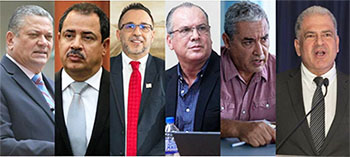 From left to right in the photo:
From left to right in the photo:
1. Johnny Araya Monge - Mayor of San José
2. Mario Redondo Poveda - Mayor of Cartago
3. Humberto Soto Herrera - Mayor of Alajuela
4. Alfredo Córdoba Soro - Mayor of San Carlos
5. Alberto Cole De León - Mayor of Osa
6. Arnoldo Barahona Cortés - Mayor of Escazú
In addition to these six municipalities, raids were also deployed in the municipalities of Siquirres and Golfito as well as the government offices of the Ministerio de Obras Públicas y Transportes (MOPT) which is the government organization responsible for managing road works. Also detained were executives of some private firms involved in asphalt processing in La Uruca, Guápiles, Aguas Zarcas and Río Claro, as well as a San Ramon firm called Explotec, whose owner, identified with the last names Cruz Porras, 52, was also detained.
The gist of the investigation said Walter Espinoza, Director of the OIJ, is about "...acts of corruption related to tenders, construction, payment of works, facilitation of irregular opportunities that created an advantageous situation for companies with gifts and bribes". He also stated that the investigation began in April 2019 and wasn`t completed until August 2021.
The OIJ also reported that, at the moment, 15 projects are being investigated in all municipalities. “These are road infrastructure projects, road maintenance and public works construction, specifically sidewalks, parks, dams,” he said, while indicating with concern that both in this operation and in another now infamous case related to highways, called Cochinilla that was carried out in June, they uncovered irregularities in public works tenders with “common” defendants, that is, people linked to both cases. The prosecutor stated that among the violations are free construction of houses, cash, vehicles, and other favors that he did not specify.
So if we are really ready to make a dent in corruption, this is a good opportunity to start cleaning house. It was good to see that the Mayor of Quepos was not in the group. GG`s experience here included the first two mayors he encountered during the 2008 to 2012 period being jailed for corruption. There`s gold in them thar asphalt trucks amigos.
 |
Operation Diamanté
(from The Simpsons) |
UPDATE 18 November:
The mayoral detentions didn`t last long as the six Acaldes, starring in a project now termed "Operation Diamanté", were released on Wednesday, November 17 (Operation Diamond - taken from the infamous mayor of the Simpson`s TV program). Apparently. Evidently the defense lawyers discovered that the prosecutors office had not filed a request for protective detention (a process widely used here to keep defendants in jail or house arrest, sometimes for a year of two before trial results are produced). The request was belatedly made after the release so it`s "Vamos a ver amigos"; we`ll see what happens.
Not to be outdone by this opportunity, the current government of Carlos Alvarado followed the arrests of the Acaldes by introducing a bill to establish term limits on mayors. Four of the six Acaldes (Araya, Redondo, Córdoba and Cole de Leon) are with the PLN party, a major competitor to the current president`s party PAC (sworn enemies might be better terms). All have more than 10 years in their positions (Araya has +30). Couldn`t be an attempt to knock out a lot of opposition in one fell swoop eh? Nawwww...
UPDATE 20 November: The Juzgado Penal de Hacienda y la Función Pública (Criminal Court of Finance and the Public Function - GG didn`t know we had one of these) imposed a six month suspension of duties on the Diamante Six beginning on 19 November. The six will also not be able to leave the country (passports suspended) or converse with witnesses. The subject of continuing the acaldes monthly salaries, ranging from ₡2.5 million ($4,000) to ₡5.7 million ($9,000) was thrown back to the individual municipalities.
Yeah baby, the political season is upon us.
UPDATE 23 November:
In an unusual event, it turns out that, while the Diamante Six are under suspension, the reigns of mayoral government in the six municipalities will revert to six women. They had been appointed First Deputy Mayors under national legislation concerning municipalities that promoted the inclusion of women. The six women have, in actuality, been acting as Mayors since the Diamante Six were suspended.
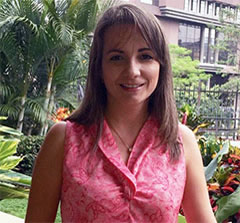 |
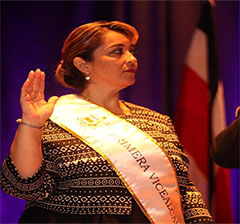 |
 |
| Paula Vargas Ramírez |
Sofía González Barquero |
Silvia Alvarado Martínez |
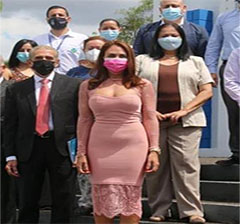 |
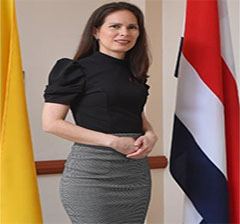 |
 |
| Karol Tatiana Matamoros Corrales |
Karol Cristina Salas Vargas |
Yanina Chaverri Rosales |
Go get `em gals.
New QR Pass Rule Suspended
Recently, in what seems to be the never ending effort to squash Covid, the government stated it would be imposing, effective December 1, the need for a patron to present a document verifying full (2x) vaccination to permit entry in every public place a citizen went. Bars, restaurants, shops, hotels etc. would all be included, the only exceptions being supermarkets and pharmacies (?). There was almost immediate reaction from the organizations like Canatur (The National Chamber of Tourism of Costa Rica) who dislike the idea saying it would reflect in significant losses during the upcoming high season. They estimated a loss of $600 million through the four month peak season.
 While they were discussing the ramifications of having to show a document with a QR (Quick Response) code to every merchant, GG tried to be a good citizen and went online to register to get his document and new QR code. First you have to register with the Health Ministry for the document and then provide, by my count, answers to 29 questions about yourself. After about an hour and a half of fiddling around with the system I was able to submit my request for a form all the while thinking I probably did something wrong and not knowing how long it would take.
While they were discussing the ramifications of having to show a document with a QR (Quick Response) code to every merchant, GG tried to be a good citizen and went online to register to get his document and new QR code. First you have to register with the Health Ministry for the document and then provide, by my count, answers to 29 questions about yourself. After about an hour and a half of fiddling around with the system I was able to submit my request for a form all the while thinking I probably did something wrong and not knowing how long it would take.
The very next day the government announced that the idea was "suspended" (essentially put on hold) indefinitely and the question would be referred to the Contentious Court (also didn`t know we had one of those - I bet they`re busy). Seems the tourism associations, including Canatur, had filed a request and the judge issued forth this gem:
“In the same way, since it has current effects, but also, given the potential but certain permanence of the effects of this mandatory measure (requirement of a QR code) it was made known through Presidential House communication number CP-1273-2021 dated October 22, 2021, in a precautionary manner, ORDERED to the President of the Republic, the Minister of Health, the Minister of Science, Innovation, Technology and Telecommunications (Micitt), to the Caja Costarricense de Seguro Social (CCSS) and the Instituto Costarricense de Electricidad (ICE), who refrain from carrying out any conduct aimed at the implementation of the QR Code, at a commercial, social, labor, tourist, recreational and/or any other level, until it is resolved by the merits the present matter, in order to safeguard the precautionary judicial protection adopted in this resolution.
The next day after that, the government stated it would give businesses, in place of an "order", an "incentive" to ask for the QR and allow them to enjoy 100% capacity in there business dealings if a business only voluntarily asked their clientele to produce the QR (so how does that policing work and get verified amigos?).
UPDATE 22 November:
With the government having been blunted by the courts ordering the suspension of the new December 1 rule, the government then told businesses that if they "voluntarily" asked for the QR doc they would be able to operate at 100%, otherwise they would have to operate at the previously established operational capacities, many some of which were required to operate at no more than 50% and some at 20%.
The business community was p-O`d to say the least, said Julio Castilla, president of the Costa Rica Chamber of Commerce: “The sanitary measure in question did not have a prior consultation process with the different businesses, nor were they given a reasonable period of time to comply with said tool, taking into consideration that there is currently uncertainty on the part of the competent authorities in its proper implementation."
That`s Spanish diplomatese for "C`mon señores get your act together!" Castilla made another good point: “Currently there are many people who do not have access to technology, a situation that would prevent them from entering a business.” And then there are many more who have the technology but don`t know how to use it - think that might discourage them from doing business?
God protect us from Bureaucrats, or at least help us overcome them.
Train Crashes Put On Land Vehicle Drivers
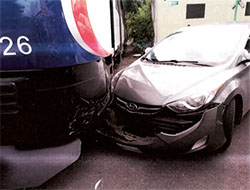 |
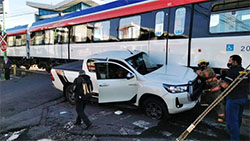 |
| We Can Make It Carlos, We Can Make It |
By the end of the second month after the new electric trains were inaugurated in April 2021 by the national train company (INCOFER, Instituto Costarricense de Ferrocarriles) there were two crashes between land vehicles and the trains. As of this writing the number of crashes has risen to a total of seven.
Despite warning lights and gates, some drivers just have to try to beat the train so INCOFER has pursued legal relief and, as a warning, fined the seven drivers involved a total of ₡105,000,000, about $167,000 or over $20,000 per driver. Chicken with the trains will now cost you a pretty penny. That`ll teach èm (maybe).
If the whole central valley had not developed over hard volcanic matter accumulated over millennia it would have been best to build a subway, but at this time it seems financially unfeasible. Then how about a raised rail system? We`d probably be ahead on repair costs alone, eh amigos. (There you go again GG, once an engineer, always an engineer).
¡Pura Vida!
TOP
Economic Drumbeat
(Costa Rica Business Happenings)
Living With The Marchamo
With everyone now expected to pay their annual Marchamo tax by December 31 because President Alvarado vetoed the fee reduction bill, the discussion continues on how unfair the tax portion of this levee is and also how it`s determined and applied.
 |
Beautiful But $14,000 Just To Put
and Keep It on the road?! |
An electronic newspaper editor recently published a lengthy article pointing out how trucks are able to satisfy the tax part of the payment at a flat rate of 8,000 colones (about $13) no matter how big or old or expensive they are.
On the other hand a private car must pay on the basis of the current book value of the vehicle. To illustrate his point the editor researched and pointed out that the cheapest car in the system (public records) currently is a 1975 Toyota, the tax portion of which is calculated at ¢59,958 ($96) while the highest assessment of a vehicle currently is for a 2021 Ferrari (photo) at more than 9,000,000 colones (more than $14,000)!
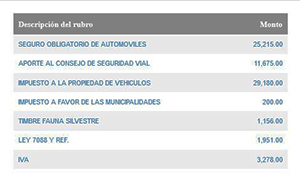 |
| Marchamo Breakdown - 1975 Landcruiser |
As it turns out (remember, GG`s experience with cars here is rental only) that the Marchamo is made up of several directed charges as shown on the summary to the left. The particular one shown to the left is the obligation of a car owner (the editor mentioned above) based on his 1975 Toyota Landcruiser (book value ₡310,000 or about $500).
The seven categories breakdown as follows ($): 1) Required National Insurance - $40; 2) Contribution to the Road Safety Council - $19; 3) Car Property Tax - $47; 4) Tax to Municipalities - $0.32 (ha, ha); 5) Wildlife Stamp - $1.85; 6) Law 7088 y Ref. (?) - $3.15; 7) Value Added Tax (do they really charge value added tax on the other taxes?; evidently so - $5.25. Grand total: $116.50.
So, on a car with a book value of $500, they charge another $116.50 in road taxes, annually. And this does not include the annual Riteve vehicle inspection which costs a minimum of ₡14,000 ($22) but often results in added repair expenses to satisfy the whims of the inspectors. And, of course it does not include the tax on a liter of gasoline, already quite substantial at over 50% of the price. GG is beginning to understand what the movement to cut the Marchamo is all about.
I`m also grateful that I made a decision to wait three months when I moved here 13 years ago. I decided not to buy at all. Instead I rely on the public transport system and/or a rental car when needed for a longer trip within Costa Rica.
Exports Resume Big Time
Costa Rican law at the moment requires employers, public and private, to pay a 13th month of wages and salaries to every employee in December of each year. This is a single payment of 1/12th the salary or wages earned in the twelve months preceding December 1. The payment is called the Aguinaldo and, unlike regular wages, is not taxed. Now, a panel of "experts" has recommended that the aguinaldo be taxed as a means of improving the country`s fiscal position.
It will be up to the legislature to make this a matter of law but its passage is doubtful and includes a likely veto by President Alvarado who is just now coming off a veto of another piece of legislation that stopped the lowering of the Marchamo vehicle tax. Alvarado has already stated his opposition to changing the aguinaldo law.
New 500 Colon Issued
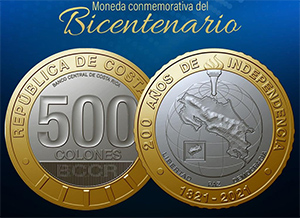 |
| New "Quinientos" 500 Colone Coin |
On November 11 the first of the new version of the 500 Colon coin (popularly known as the "Quinientos" began to be distributed by the Central Bank of Costa Rica. They have received five million units of this coin that will be distributed through the following banks as they request them: Banco Nacional, Banco de Costa Rica, BAC Credomatic, Banco Promérica and BCT Bank.
The new coin is rather artful comprised of a silver-plated copper and nickel core and an outer ring made of an alloy of copper, zinc and nickel. The front side denotes that it is Costa Rican while on the backside is a relief of the country and for the first time includes an outline of the Isla de Cocos (lower left on the back side). When turned sideways the "500" on the front changes to the acronym “BCCR” for Banco Central de Costa Rica.
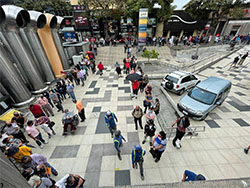 |
| Numismatics in Line for New ₡500 Coin |
At the current dollar/colon exchange rate the Quinientos is equivalent to about $0.79. But that didn`t stop the numismatic crowd which numbered in the hundreds on November 23 when a collectors version of the new coin went on sale at the Central Bank creating the line shown in the photo. The price? ₡25,000 (about $40). The collectors coin, of course with no mars, scratch or dirt buildup came with a numbered certificate case presentation.
GG wonders what it costs to produce each unit, which is a fairly fancy coin and must be rather expensive to produce?
Exports Resume Big Time
Total exports from Costa Rica posted a gain of $12 billion during the period of January to October of this year as compared to last year, same period. This is a gain of 26%, and compares well to North America (28%) as a whole, to Central America (27%) and to the gain here registered last year during the height of the pandemic of -3%. It also marked the highest percentage gain in the last five years: 2017: +8%, 2018: +6%, 2019 - +2%, 2020: -3%, 2021: +26%.
The leading gain by category was in the Medical Devices sector which reached $1.2 Billion and reflects the increasing importance of this segment to the Costa Rica economy. The largest categories following Medical Devices were , syrups and concentrates for soft drinks (+ US$125 million), pineapple (+ US$110 million), electrical cables (+ US$85 million), iron or steel bars (+ US$70 million) and Palm Oil ($66 million).
At last we`re seeing some build back of the economy, hopefully to normal.
¡Pura Vida!
TOP
Latin America Updates
(Major Events In Neighboring Countries)
Colombia
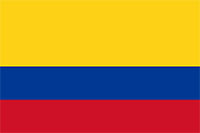
President of Colombia, Ivan Duque, joined in the discussions at the COP26 Climate Change meeting in Glasgow, Scotland in the last week of October, where he expressed his government`s commitment towards reducing carbon emissions in Colombia by 45% by 2030. He also stated that his country represents 6% of all greenhouse gas emissions globally. Funny that, at 51 million population in a world with 7.753 billion people, Colombia would represent .6% in population.
Did you make the decimal point slip Ivan or did I, or is Colombia really that developed. Duque classified his speech as "diaphanous" which GG had to look up and found it means "clear and or transparent"; OK, sure Ivan, it`s diaphanous now.
Nicaragua
 In the continuing effort to make sure he`s re-elected, Daniel Ortega`s government was challenged in early November by the great arbiter of all things Network, i.e., Facebook. Zuckerberg`s Zappers canceled over 1,000 accounts they called "trolls", people posing as individuals but actually working to blunt bad messages about Danny`s election or add positive statements about how great everything is working out in Nicaland these days. The social media company said: "The `troll farm` was a coordinated effort to manipulate public discourse using fake accounts – and was intended to amplify pro-government and anti-opposition content."
In the continuing effort to make sure he`s re-elected, Daniel Ortega`s government was challenged in early November by the great arbiter of all things Network, i.e., Facebook. Zuckerberg`s Zappers canceled over 1,000 accounts they called "trolls", people posing as individuals but actually working to blunt bad messages about Danny`s election or add positive statements about how great everything is working out in Nicaland these days. The social media company said: "The `troll farm` was a coordinated effort to manipulate public discourse using fake accounts – and was intended to amplify pro-government and anti-opposition content."
A spokesperson for Alphabet Inc, another property owned by Google, and which owns YouTube (does Google own everything these days?), said the company had terminated 82 YouTube channels and three blogs as part of its ongoing investigation into coordinated influence operations linked to Nicaragua.
Welcome to the world of social media campaigning and censorship; be careful what you read and believe amigos, Big Tech Brother wants to have the last word.
Post-Election Update: As expected, current president Daniel Ortega, after incarcerating some 39 political opponents, including 7 presidential opponents, either in jail or under house arrest, "swept" the national election held November 7 with 75% of the vote cast for Ortega and his Vice President wife, Rosario Murillo.
The actual turnout of voters was estimated to be very low. CID Gallup, a Gallup Poll subsidiary for Latin America countries, just before the elections put the favorable rating of Señor Ortega in Nicaragua at 34%. Urnas Abiertas, a private election watchdog focused on Nicaragua, estimated a national abstention rate from the election at 79-84%. La Prensa, the largest private newspaper in Nicaragua (or at least it was before the government began interfering with their newsprint supplies) reported that state workers had been ordered to vote under penalty of losing their job and should show their ink-stained finger to prove it. La Prensa also reported that a number of people they interviewed simply cast a blank vote in order to get the stain.
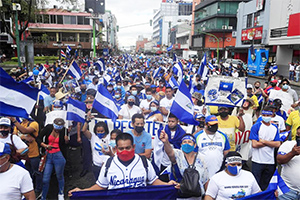 The process was condemned as a farce by many countries including Costa Rica who refused to recognizes the results as valid. In Costa Rica, where the largest Nicaraguan-born population outside the home country resides (approximately 500-600,000), the election brought on a large demonstration of Nicaraguans in downtown San José (photo right). One of those demonstrating against the process was self-exiled Zoilamérica Ortega Murillo, the daughter of Vice President Rosario Murillo and step-daughter of president Daniel Ortega.
The process was condemned as a farce by many countries including Costa Rica who refused to recognizes the results as valid. In Costa Rica, where the largest Nicaraguan-born population outside the home country resides (approximately 500-600,000), the election brought on a large demonstration of Nicaraguans in downtown San José (photo right). One of those demonstrating against the process was self-exiled Zoilamérica Ortega Murillo, the daughter of Vice President Rosario Murillo and step-daughter of president Daniel Ortega.
¡Solo Bueno!
TOP
Golden Gringo Chronicles Redux
(The Journey From 2014 To The Present)
While I was looking around for a topic for this month`s Chronicle I came across a copy of the first book I wrote on Costa Rica, entitled "The Golden Gringo Chronicles - A Practical Guide To Retirement in Costa Rica" (left). It covered my experiences as an ex-pat from September 2008 (when I first moved here) up to and including 2014. The idea was to incorporate seven years experience into narrative form, turning the experience into an interesting book; I hope and think I succeeded.
The reader may remember that I started the Golden Gringo Chronicles in 2008 as a simple monthly newsletter to my family and friends in the United States. The newsletter didn`t receive the current name until the second year it was published. The reason for having "Golden" in the title was because I`d be living my "golden years" here and also for being so lucky (or "golden") to have found such a great place to retire. Adding Gringo to the name was an obvious addition.
I thought it might be a good idea to update and expand upon some of the things that have happened to your Golden Gringo since that first book came out, in other words, the last seven years from 2015-2021. Who knows, maybe I`ll work the info from this article into a sequel for the first book. Counting this month`s newsletter, the number of monthly editions has now reached 160, the number of feature articles covered in the monthly editions has reached over 300 and the newsletter now goes out to almost 2,000 readers each month. GG is having fun and I hope the readers are too!
The archives (Chronological, Topical and Restaurants) provide easy access to all the topics and articles that I`ve written. But let`s review the new experience by time period, pointing out the more interesting pieces that were written about during each period.
2015 (Editions 77 to 88)
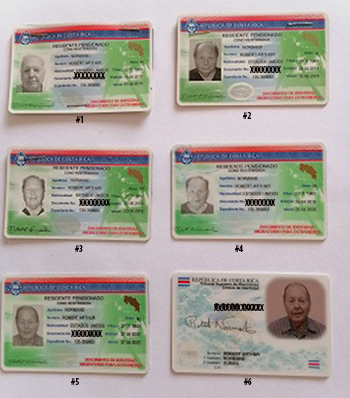 |
| GG`s Six Cédulas So Far |
By 2015 GG had been residing here for over six years and was operating under his 3rd Cédula (residency card). I had not gotten my first Cédula until 2012, three and a half years since I relocated here from Florida and after encountering delays resulting from not understanding the Cédula approval process. This was exacerbated by dealing with a legal firm that turned out to be a largely incompetent, or at least unknowledgeable, outfit.
The history of my Cédulas is depicted in the photo to the right (official Cédula numbers have been blacked out to avoid clever hackers an opportunity to play games with my info).
Cédulas back then were renewed every two years. My Cédula in 2015 was #2. I belatedly came to understand that one could choose to renew as a "permanent" resident after living here for 5 years. But I didn`t and then I became more interested in what a citizen-Cédula (#6) would bring. When I found out that both the U.S. and Costa Rica permit joint citizenship I decided to pursue that instead of permanent residency. And, of course, I had also become very comfortable living here.
During 2015 I wrote a number of articles about living in the local culture (Futbol, Fiestas, Open Markets, the Beaches, the Life Guards, the Rock Islands, the Hospital, tours such as Canopy and Catamaran; Reptiles, and even visiting other beaches such as the Nicoya and Jacó, as well as lots of other things you can do at our beach here. Then there also were articles on food culture (Tamales, Papaya, Coffee); there are many traditional dishes, it`s not all rice and beans folks, especially when you live in a tourist haven of an area that has at least five dozen restaurants.
One of the more interesting places outside of Costa Rica that GG visited in 2015 was a jaunt to Argentina; at the bottom of South America and eight hours by air from San José. I stayed at a friend`s house for three and a half weeks on a cat-sitting project while my friend went to the Caribbean (I got along well with the feline by the way). That extended stay gave me plenty of time to explore the beautiful city of Buenos Aires as well as do a day trip to Montevideo, Uruguay.
2015 (2016-2017 (Editions 77 to 88)
By 2016 GG had developed a certain knowledge base about my new resident country. The efforts that dominated the earlier years (getting official residency, figuring out the best way to use the combination of Costa Rican and U.S. banking, joining and using the national health system) had been successfully completed and resulted in a certain level of comfort. The old Border Runs (quick trip to Nicaragua or Panama every 90 days to renew a temporary visa had been supplanted by a Cédula that ran for at least two years and which avoided a need for a regular, periodic visa. Life was getting easier.
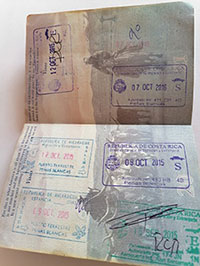 After reviewing the stamps in my passport(s) it showed that I also used the period 2015-2017 to visit neighboring countries regularly (some four times to Nicaragua and about the same to Panama). That developed some understanding about our closest neighbors in places like San Juan del Sur and Granada in Nicaragua as well as the town of David and the Islands of Bocas del Toro in Panama.
After reviewing the stamps in my passport(s) it showed that I also used the period 2015-2017 to visit neighboring countries regularly (some four times to Nicaragua and about the same to Panama). That developed some understanding about our closest neighbors in places like San Juan del Sur and Granada in Nicaragua as well as the town of David and the Islands of Bocas del Toro in Panama.
In the first issue of January, 2016, I wrote a bio on myself (don`t know why - just nostalgia setting in perhaps) and called it the Morphology of a Golden Gringo; for a good laugh, go see it HERE. Many of the articles I wrote during this period were related to the growth and development of the Quepos area. Other articles talked about involved expat tips on getting along here that included comments about supermarkets, small town stories, getting along as an expat.
I like to think that the structure and content of the Chronicles broadened during this period. For the first time I wrote an article featuring a professional person, namely, my dentist, a young gent I respected and who had been helping me on various dental concerns, including a broken tooth acquired from trying to bite something I shouldn`t have. He fixed the tooth efficiently and at minimum cost when I first met him in 2012. That experience prompted me to start a new section in the Chronicles I called Profiles in Quepos which, as of this writing, has now featured some one dozen business and professional people who essentially make up the mosaic of why I love Quepos.
And then, of course, I was continuing to come across more and more legends of Costa Rica. I became infatuated with the Legend of Zurqui, a story about a young girl, the daughter of a cacique (tribal chief), and her happenstance meeting with the son of another cacique, a story that turns into a love affair. The story ends tragically when the father-cacique of the young lady sends warriors to find the two rebels. The boy is killed and the girl undergoes a strange metamorphosis that turns her into a bright blue morpho butterfly, one of the most beautiful creatures in Costa Rica.
So I wrote my second book on Costa Rica, called Mariposa (after the butterfly). It came in as a 100 page novel (in English, but it came out 131 pages in Spanish). It describes the love affair and offers a more gentle ending. That was the beginning of another section in the GGC format called, unsurprisingly, Legends of Costa Rica, which now contains 18 articles on various legends in Ticoland.
 It was during this period that another thing became obvious. I had been involved in renewing my cédula several times and I thought new people who are considering a move here might appreciate some guidance on how to do the process more knowledgeably and more easily. So I formed a section called Golden Gringo University (GGU) where I wrote a more thoughtful and serious
It was during this period that another thing became obvious. I had been involved in renewing my cédula several times and I thought new people who are considering a move here might appreciate some guidance on how to do the process more knowledgeably and more easily. So I formed a section called Golden Gringo University (GGU) where I wrote a more thoughtful and serious
approach on "how to" questions such as obtaining residency. It has since progressed to other areas of experience like understanding the government structure and the historical basis for the culture here as well as the process of naturalization in becoming a citizen.
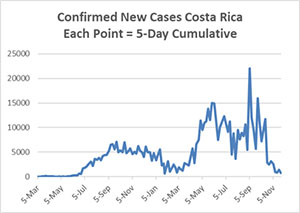 |
New Covid Cases
(5 day Increments Since Early 2020) |
Prior to January 2020 the Health section of the Chronicles was almost exclusively tied to the health benefits in Costa Rica derived from good food and also information about avoiding some dangers related to wild plants and animals. With the advent of the Covid situation we began to keep track of those related numbers and watched them multiply.
We also selected certain other stats, such as corresponding figures for The World, the U.S.A. and several other Central American Countries. At the moment we are happy to report that the new case load in Costa Rica is plunging and the death rate from the disease has been lower than any of those areas just mentioned. Are we getting closer to "herd immunity"? At this point we can only hope to God that`s so.
2018-2021 (Editions 113 to 160)
In the last three years GG considerably expanded the information base offered to the readers on several fronts including the Profiles going from one to a dozen. The Costa Rican cultural section was also expanded by 14 more feature articles than before, while still finding time to write about various topics like the Greening of Costa Rica, wildlife such as bats, trans gender crocodiles and sloths. Also there was plenty of time to write about a variety of miscellaneous items such as: the National Cathedral, New Plastic Money, Tico Sayings, Omens and Superstitions, Sensing the Paranormal and Understanding Tico Horn Signals (some similarity to sensing the paranormal).
The articles that were written for these 38 editions, together with all of the previously written articles from earlier time periods (currently total about 320) finally ended up being organized into 15 categories:
- About Quepos & Manuel Antonio (28)
- Profiles in Quepos (11)
- Agriculture (20)
- Costa Rica Wildlife (25)
- Costa Rican Culture (49)
- Getting Residency (9)
- Golden Gringo University (12)
- Health/Medical (26)
- History of Costa Rica (24)
- Legends of Costa Rica (18)
- The Beaches (14)
- Weather and Tremor Tales (17)
- Other Places in Costa Rica (15)
- Other Latin American Countries (34)
- Miscellaneous (15)
So the Golden Gringo Chronicles ended up as a repository of information, some of it being important to adjusting to the expat life here and some of it secondary but hopefully informative and entertaining. One of the things I noticed was how the size of individual editions has risen steadily since the early days when an edition often totaled a couple of thousand words to when, a couple of years later, it rose to 4-5,000 words and in recent years somewhat inflated by the pandemic, an edition has been running 7-9,000 words (this issue clocks in at abut 8,100 words).
As a fledgeling Costa Rican I felt obligated to learn more about the background of my chosen retirement country. Over this time some 24 articles on various aspects of Costa Rica history were added to the History Section in the Chronicles Archives. My interest in Costa Rican history and legends also served as a premise to write my third book about Costa Rica, Las Esferas, The Mystery Spheres of Costa Rica. (Published in 2020)
What I liked most about this story is that it is, at the same time, history, legend and perhaps spirituality. These spheres (over 300 have now been found ranging from basketball size up to over 8 feet in diameter) have been a mystery to everyone who has investigated them. They were not found until 1947, and then only by accident, when the soil on a farm property in southern Costa Rica was being turned over to make a plantation.
The spheres are dated to pre-Colombian times (before 1500 AD) because they were found in the ruins of an old building and also because the Spanish, in 300 years of occupation never recorded anything about them. Both skeptics and Ancient Astronaut Theorists admit the spherical tolerances are such that producing them using pre-Colombian technology (tools of stone) was not possible.
GG loves this stuff!
___ ___ ___
Don`t forget, the entire archived selection of topics encompassing 160 editions and over 300 links to individual articles can be reviewed and plundered for information here:
Golden Gringo Chronicles, Costa Rica, Topical Archives
Keep reading amigos (and offer suggestions) and above all don`t forget...
¡Pura Vida!
TOP
Rumble and Weather Talk
(Shaky Happenings & Weather Observations About the Pacific Rim)
Rumbling
Another quiet month to report. The tremor chart for Costa Rica as of November 25 showed nothing for the month in the +4.5 Richter level. The only sizeable quake in the extended neighborhood was a 6.2 jolt in Southern Nicaragua which may have been slightly felt in some northwestern provinces of Costa Rica.
Check Out Recent Earthquakes All Around the World Posted by the U.S.G.S. Recent Quakes
|
Weather
The rainy season continues typical with some sort of shower activity most days. In the second half of November there were more instances of the sun breaking though more frequently as if it was time for the high (and dry) season to begin.
¡Pura Vida!
TOP
Search the Golden Gringo Chronicles Archives for Topics That Interest You
You can use our Archives to search for anything that has been written in more than 320 feature articles of the Golden Gringo Chronicles plus find Broken News items and ROMEO restaurant reviews. Enter your topic or item to search in the Google Search Routine below and follow the links offered from the search results.
Suggestion: Enter only a simple, precise and unique as possible key word or two in order to narrow the number of references retrieved:
Golden Gringo Chronicles - Enter Search Here
Readers: Our publication is open to suggestions regarding future articles
and will accept pieces written by others but we reserve the right to decline
anything that the
editorial staff (that's GG) thinks is inappropriate for this format. Send proposals, comments, suggestions, ideas, meaningless statements and jocular observations concerning the Chronicles to GG here: gg@goldengringo.com.
¿Que es Eso? Department
(¿What is That?)
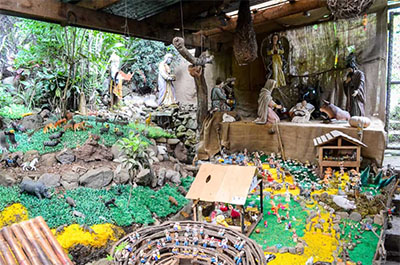
A busy hotel photo?
Somebody`s put together a rather elaborate garden?
Answer in
What's-in-a-Word
section below.
¡Pura Vida!
TOP
Health Stuff
| Note: The information given in this section is offered as news information only and does not indicate GGC confirmation or denial of the accuracy of the treatment or a recommendation to pursue it, nor can we or do we guarantee the efficacy of the results nor validity of the conclusions proffered.
(How's that for a disclaimer amigos?) |
Covid-19 Vaccination Status
By the 25th of November the Health Ministry reported that for the target vaccination segment (+12 years of age) the single dose penetration rate had reached slightly over 90% of the population while for those having received double doses it had reached almost 74%. That may have something to do with the results shown in the next section below.
New Cases of Covid-19 Rate Decline

Foreign news agencies such as Reuters, as well as the Costa Rican Health Ministry are reporting a vaccination rate of just under 80% based the total number of vaccinations dispensed divided by the total of people eligible.
Since early September and as of Nov. 25 the new case load of Covid-19 in Costa Rica has undergone a very substantial drop as shown in the graph to the left.
Are we approaching "herd immunity" (do you think health stats people might come up with a better term for we cattle?) - hopefully yes, we seem to be moving in the right direction anyway.
¡Pura Vida!
TOP
Travel Quote of the Month

(Wanna guess the airline?)
¡A Cachete!
TOP
GGC Bookshelf
 GGC Publications Group is the parent organization that publishes the Golden Gringo Chronicles as well as a number of books and paraphernalia related to the Chronicles and Costa Rica. The GGC Bookshelf also includes works from a number of other authors that belong to the Quepos-Manuel Antonio Writers Group in which GGC has been a founding member.
GGC Publications Group is the parent organization that publishes the Golden Gringo Chronicles as well as a number of books and paraphernalia related to the Chronicles and Costa Rica. The GGC Bookshelf also includes works from a number of other authors that belong to the Quepos-Manuel Antonio Writers Group in which GGC has been a founding member.
Here are the books currently on our bookshelf:
All of the above books are available on Amazon.com and the "Read More" links above will lead you to them. You can find more detail on all of them on our GGC Publications Page.
GGC Products Store
GGC Publications also offers some accessories and paraphernalia related to the Chronicles and with Costa Rican themes, to wit:
T-Shirts:

a.
Golden Gringo Chronicles with Logo
b.
Official Golden Gringo with Monkey on Banana Hammock
c.
¡Quepo en Quepos! ("I Fit In Quepos!") with Photo of Quepos
d.
Wanna Monkey Around? - Come on Down! (shown) with Photo of White Faced Monkey, e.
It's OK to be Slothful with photo of Three-Toed Sloth.
The t-shirts are available in several themes, colors, styles and sizes. See them all
HERE.
Coffee Mugs:
a. Golden Gringo, b. Wanna Monkey Around?, c. It's OK to be Slothful
See them all HERE:
What's life without a great cup of Costa Rican coffee? And it tastes even better in a Golden Gringo Chronicles mug!
To see ALL the products available in the Golden Gringo Store go here: GGC Store.
¡Solo Bueno!
What's-in-a-Word
"Tell me and I forget; teach me and I remember; involve me and I learn"
– Benjamin Franklin
Answer to Que Es Eso?
a. Answer to Que Es Eso
The scene is nothing more than what Costa Ricans call a Christmas Portal, more likely known in the north as a manger scene or what we called in my neighborhood a "creche". One of the ways that many Costa Ricans still celebrate by small groups of people walking through the neighborhood singin carols and commenting of the neighbor`s portal effort.
b. Word of the month: Diaphanous
This word was used by the President of Colombia (see Latin American Update section and it sent me scurrying for the dictionary (well, at least to my online dictionary.com) and found this:
Adjective: very sheer and light; almost completely transparent or translucent, delicately hazy.
Is everything diaphanous now that we`ve seen that definition?
¡A Cachete*!
*A Cachete is kind of street slang. Literally A Cachete means "Slap" on a cheek, but it`s used in this area to denote someone with full cheeks meaning all is going well and as an alternative answer to Todo Bien and Pura Vida for "Como estas?".
TOP
ROMEO Corner
(Retired Old Men Eating Out)
For the first time in 160 editions the ROMEOs did not meet in November simply because of the press of other holidays like Thanksgiving and the December 1 national observance of Army Abolition Day here which has been moved up to November 29 which, in turn, portends an higher normal activity here for that weekend. ROMEOs will reconnoiter in December.
If you`d like, you an go to the following link for our Restaurant Archive and follow the subsequent links to some three dozen restaurants we`ve reviewed in the last three years:
Golden Gringo Chronicles, Costa Rica, Restaurant Archives
And To Review Rating System Go Here: R.O.M.E.O. Rating System
|
 |
| |
| |
Value Index |
¡Pura Vida!
TOP
Opt-In Here to Receive Your Free Monthly Copy Of
The Golden Gringo Chronicles
The Golden Gringo Chronicles is a free newsletter that is non-political, non-commercial and, hopefully, informative and entertaining. By signing up you will receive an email each month around the first of the month giving you the links to the latest edition as well as to each individual feature and departmental section.
CLICK HERE TO SIGN-UP FOR THE GOLDEN GRINGO CHRONICLES
or Email me at gg@goldengringo.com, or use our Website at: www.goldengringo.com

Bob Normand, Editor & The Golden Gringo
Pura Vida!
To Contact GGC World Headquarters (yuk, yuk) to makecomments, suggest topics or criticize my bad jokes, just send an email to: gg@goldengringo.com.
Be pithy but kind; I'm sensitive.
Unsubscribe from Golden Gringo Chronicles

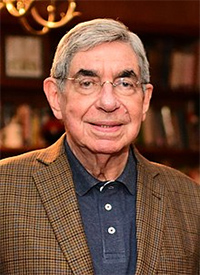 Oscar Arias was born 13 September 1940 in Heredia, Costa Rica and became president of Costa Rica for two terms: 1986-1990 and again in 2006-2010. Arias went from graduating high school in San José to Boston University with the intention of studying medicine, but he soon returned to his home country and completed degrees in law and economics at the University of Costa Rica. He also studied in England obtaining a Doctorate in Political Science from Essex University. During his career he received over 50 honorary doctorates from various colleges and universities including the universities of Harvard, Princeton, Dartmouth, Wake Forest and Washington as well as the colleges of Oberlin and Ithaca.
Oscar Arias was born 13 September 1940 in Heredia, Costa Rica and became president of Costa Rica for two terms: 1986-1990 and again in 2006-2010. Arias went from graduating high school in San José to Boston University with the intention of studying medicine, but he soon returned to his home country and completed degrees in law and economics at the University of Costa Rica. He also studied in England obtaining a Doctorate in Political Science from Essex University. During his career he received over 50 honorary doctorates from various colleges and universities including the universities of Harvard, Princeton, Dartmouth, Wake Forest and Washington as well as the colleges of Oberlin and Ithaca.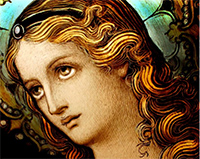 In a country where Roman Catholicism is the official State Religion (there are movements afoot to change this), this day is celebrated most by devout Catholics. The holiday is listed officially as an "Observance", meaning businesses stay open and workers are paid for the day only if they work - pretty much a business as usual day. Celebrations of the Observance are largely done in local churches.
In a country where Roman Catholicism is the official State Religion (there are movements afoot to change this), this day is celebrated most by devout Catholics. The holiday is listed officially as an "Observance", meaning businesses stay open and workers are paid for the day only if they work - pretty much a business as usual day. Celebrations of the Observance are largely done in local churches. The U.S. President was busy at the United Nations sponsored Glasgow Climate Change Summit (named COP26) inviting other major leaders to yet another climate change meeting he`s organizing for April in the U.S.. The Glasgow summit was most notable in it`s absence of high-population carbon polluters such as China, Russia and Brazil.
The U.S. President was busy at the United Nations sponsored Glasgow Climate Change Summit (named COP26) inviting other major leaders to yet another climate change meeting he`s organizing for April in the U.S.. The Glasgow summit was most notable in it`s absence of high-population carbon polluters such as China, Russia and Brazil. GG used to walk off his dinner by going down to the futsal and cheering on the kids, several of which this time recognized me from before. I enjoyed that routine 3,4,5 times per week in earlier days. Somehow I got nicknamed by the kids as Bob Esponja (Sponge Bob) but they never made me a cake (wah) like the one to the right.
GG used to walk off his dinner by going down to the futsal and cheering on the kids, several of which this time recognized me from before. I enjoyed that routine 3,4,5 times per week in earlier days. Somehow I got nicknamed by the kids as Bob Esponja (Sponge Bob) but they never made me a cake (wah) like the one to the right. From left to right in the photo:
From left to right in the photo:






 While they were discussing the ramifications of having to show a document with a QR (Quick Response) code to every merchant, GG tried to be a good citizen and went online to register to get his document and new QR code. First you have to register with the Health Ministry for the document and then provide, by my count, answers to 29 questions about yourself. After about an hour and a half of fiddling around with the system I was able to submit my request for a form all the while thinking I probably did something wrong and not knowing how long it would take.
While they were discussing the ramifications of having to show a document with a QR (Quick Response) code to every merchant, GG tried to be a good citizen and went online to register to get his document and new QR code. First you have to register with the Health Ministry for the document and then provide, by my count, answers to 29 questions about yourself. After about an hour and a half of fiddling around with the system I was able to submit my request for a form all the while thinking I probably did something wrong and not knowing how long it would take.






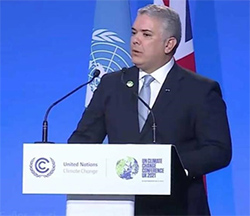

 The process was condemned as a farce by many countries including Costa Rica who refused to recognizes the results as valid. In Costa Rica, where the largest Nicaraguan-born population outside the home country resides (approximately 500-600,000), the election brought on a large demonstration of Nicaraguans in downtown San José (photo right). One of those demonstrating against the process was self-exiled Zoilamérica Ortega Murillo, the daughter of Vice President Rosario Murillo and step-daughter of president Daniel Ortega.
The process was condemned as a farce by many countries including Costa Rica who refused to recognizes the results as valid. In Costa Rica, where the largest Nicaraguan-born population outside the home country resides (approximately 500-600,000), the election brought on a large demonstration of Nicaraguans in downtown San José (photo right). One of those demonstrating against the process was self-exiled Zoilamérica Ortega Murillo, the daughter of Vice President Rosario Murillo and step-daughter of president Daniel Ortega.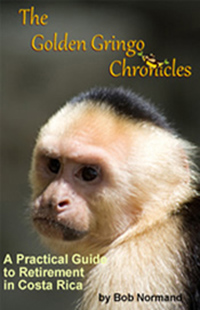

 After reviewing the stamps in my passport(s) it showed that I also used the period 2015-2017 to visit neighboring countries regularly (some four times to
After reviewing the stamps in my passport(s) it showed that I also used the period 2015-2017 to visit neighboring countries regularly (some four times to 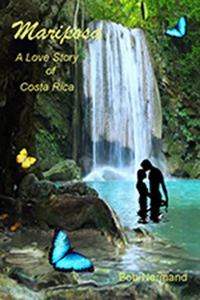
 It was during this period that another thing became obvious. I had been involved in renewing my cédula several times and I thought new people who are considering a move here might appreciate some guidance on how to do the process more knowledgeably and more easily. So I formed a section called
It was during this period that another thing became obvious. I had been involved in renewing my cédula several times and I thought new people who are considering a move here might appreciate some guidance on how to do the process more knowledgeably and more easily. So I formed a section called 





















